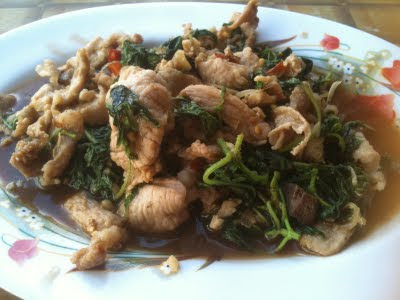Thursday, September 15, 2011
Cambodian Cooking: 'Frying' With Water
The other great meal at that Khmer greasy-spoon I told you about a couple of blogs back was chicken, pork or beef fried with lemon grass, holy basil and chilli.
The dish is delicious – and is easily one of my favourite Cambodian recipes. It shares similarities with other dishes in SE Asia, but still has a taste of its own – and sums up the ‘fast, fresh and fragrant’ hallmarks of Cambodian cooking.
It also uses Cambodia’s beloved cooking technique of 'frying' with water. Because little fat is used in cooking over here, small splashes of water are added to give a fast bubble to meat, fish or vegetables ‘frying’ in a wok. It means you don’t get the same singed, caramelised flavour to the meat, but it does make it tender.
Vegetables cooked this way are far better. In every restaurant kitchen garnish section I’ve worked on, the spinach was always fried in clarified butter in a very hot pan, almost as though that was the only way to cook it, and anything else was “wrong”.
But fry it the same way, substituting the fat for the same amount of water, and it’s fresher-tasting and far less greasy. Purple sprouting broccoli cooked that way is especially good.
(Pic: Beef with lemon grass, holy basil and chilli)
The clove-like taste of the holy basil works well with the three different chilli flavourings, and gives it a deep, spicy flavour, which is lightened by the zesty, perfumed taste of lemon grass – the signature ingredient of Khmer cuisine.
It also helps destroy the popular myth that Cambodian food isn't spicy. I’ve tasted the dish in many restaurants, and it’s always eye-watering - just like the green mango, papaya, and Khmer beef salads they serve, particularly in the Battambang region.
While it’s true that with the vast majority of Cambodian recipes, little or no chilli is used in the cooking, and when heat is needed, cooks are more likely to turn to fresh, green Kampot peppercorns or ground black or red pepper.
It doesn't mean Cambodians don't like their chilli. They just serve it separately – usually sliced chilli in a saucer, pickled bird eye chillies in a jar, or a fiery relish of sliced red chillies and garlic, so people can put as much on as they want.
That dish – simply called “hot of pork” in that wonderful cafe in Cambodia’s culinary capital of Siem Reap – was a meal aimed squarely at chilli aficionados, and is one of the best I’ve tasted so far on my travels through Cambodia.
It needs no accompaniment, other than a soup, a bowl of sticky rice, and a kettle of cold tea poured into a mug of ice and drunk through a straw.
THE COOK finely sliced some pork fillet, and then bruised and finely chopped a small lemon grass stalk. He heated a wok and poured in half a tablespoon of oil, smeared it round the sides, and then spooned the rest of the oil back into an old paint tin.
He fried the lemon grass for 20 seconds, and then tossed in the pork, stirred it for a second, and then added a splash of water, and stirred again.
He “fried” the pork and lemon grass in water for a minute, always topping up with another splash as the liquid evaporated. He then added half a tablespoon of fish sauce, the same of soya sauce, and a sprinkle of sugar and salt. He was about to reach for the MSG, but this time I was ahead of him, and said I’d have it without.
He cooked the meat for another minute, topping up with a little more water all the time, but not too much to lose the fast bubble. He then threw in two handfuls of holy basil leaves and a finely chopped red bird eye chilli. The leaves quickly began to wilt, and for a moment the kitchen was filled with the acrid fumes of singed chilli seeds.
But he didn’t stop there – he added a splash of bottled chilli sauce (the fairly hot, orange-coloured, chilli and garlic variety you get on restaurant tables in Asia), and a teaspoon of fried chilli paste (finely chopped large, dried, red chillies fried in oil for a few minutes until slightly singed and then stored in a jar).
By now, the holy basil had wilted to a tenth of its size, and had a furry, spinach-like texture. The cook added a little more water, to get the right gloop to the sauce, and then served it up.
This blog was brought to you by the words...
Cambodian cooking,
Cambodian cuisine,
fried chilli paste,
frying with water,
holy basil and chilli,
Kampot pepper,
pork fried with lemon grass
Subscribe to:
Post Comments (Atom)









3 comments:
What a fascinating technique. Really interesting post. Good work on getting in there pre-MSG this time...
Great tip. Intriguing. I'll give it a go.
great blog as always!
Post a Comment